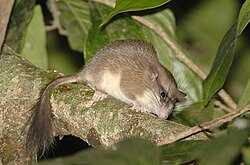| Malabar spiny dormouse Temporal range: Late Miocene to Recent | |
|---|---|
 | |
| Scientific classification | |
| Kingdom: | Animalia |
| Phylum: | Chordata |
| Class: | Mammalia |
| Order: | Rodentia |
| Family: | Platacanthomyidae |
| Genus: | Platacanthomys Blyth, 1859 |
| Species: | P. lasiurus |
| Binomial name | |
| Platacanthomys lasiurus Blyth, 1859 | |
 | |
The Malabar spiny dormouse (Platacanthomys lasiurus) is a species of muroid rodent endemic to the Western Ghats of India. It is the only extant species in the genus Platacanthomys and although resembling a dormouse, it is not closely related. About the size of a brown rat, this arboreal species lives in tree holes in dense forest habitats in a small family group. They are distinguishable from other species in the area by their bushy tuft tip to the tail and the spiny fur on the back.











